MANAGE FLOODING
PREVENTING ROAD FLOODING
Beavers probably see a culvert beneath a road as a hole in an otherwise fine dam. So they try to plug the hole and a flooded road may result. Semi-circular fences of sturdy wire mesh are used to prevent road flooding by protecting culvert inlets from such plugging. These are called diversion dams (because they divert the beaver’s attention from the culvert), or pre-dams (because they stimulate the beaver to build a dam against the fence).
Concrete reinforcing wire or stronger gauge fencing, supported by metal fence posts, can be used to make the fence. Where roadbeds are built quite high with respect to the water level and the water level upstream is not a problem, installing a diversion dam may be sufficient.
The photo shows a diversion dam at Gatineau Park in Canada. See how the beavers have built over the wire fence making it invisible. Note that the culvert inlet is also protected by a cylinder of wire fencing, which has become rust-colored and blends in well with the scenery.
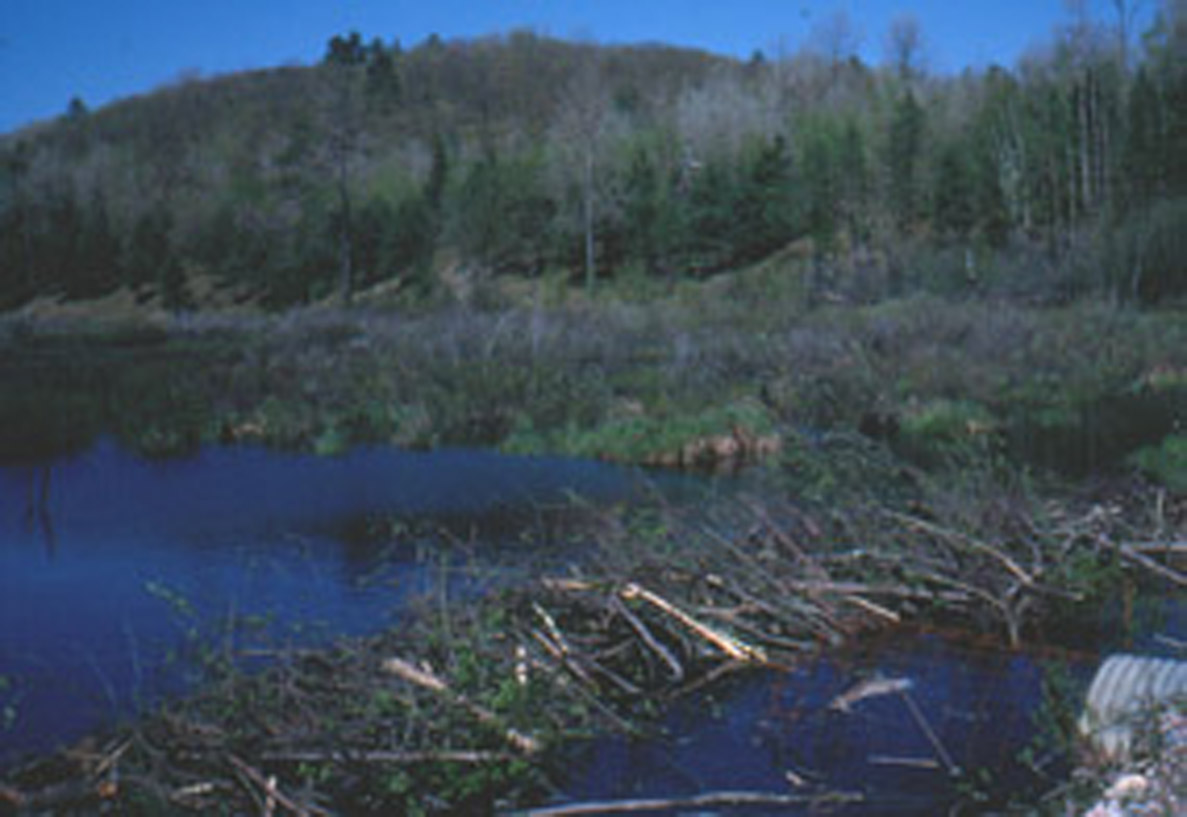
Many beaver flow device studies indicate that modern water level control devices
are effective, economical and can save valuable wetlands.
A 2006 report from Tufts University showed that 93% of clients were satisfied
with the results of beaver flow device installations done by professionals.
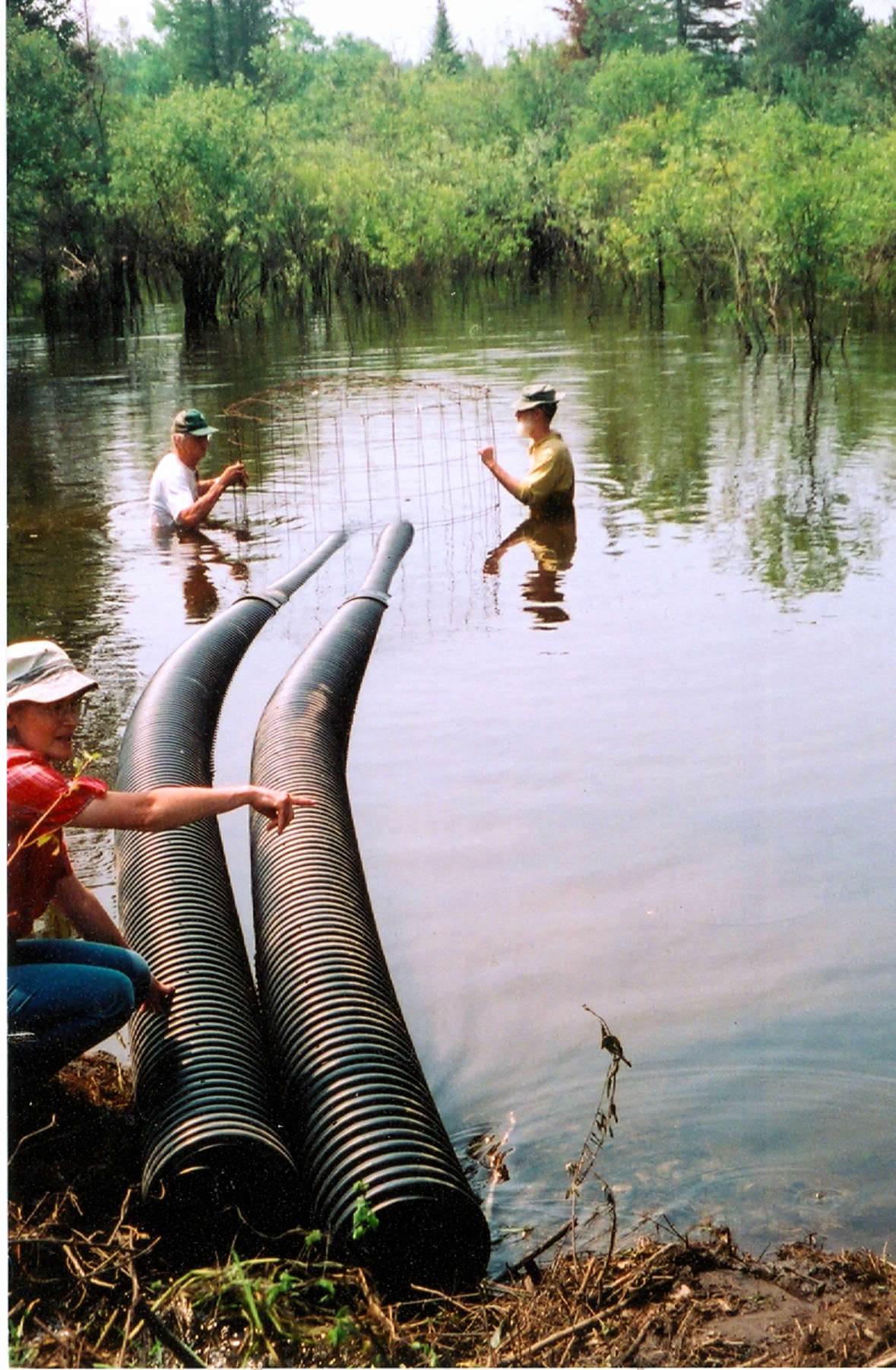
PIPE & CAGE (FLEXIBLE LEVELER) SYSTEM
Usually, it is necessary to control the upstream water level, and a pre-dam fence alone is not sufficient. A flexible leveler system with one or more flex pipes is then added through the fencing. (Such pipe systems may also be set directly in a beaver dam, to control the water level upstream.) Large diameter (usually 10- or 12-inch) black, corrugated polyethylene pipes are used, according to the size of the watershed and the slope of the terrain. The pipe inlet, which is protected by a five-foot-diameter cage of sturdy fencing, is placed low enough, so that the bottom of the pipe, where it sits in the fence (or dam), will become the new upstream water level. Often a beaver will appear during the installation.
The beavers will then dam against the pre-dam fence while water continues to flow freely. These systems may require annual or semi-annual maintenance that takes much less time and expense than previously spent by road crews unclogging culverts. Such cost effective systems, which were first used at Canada’s Gatineau Park in the 1970s, are currently in place at many locations in North America, where they save taxpayers’ money while saving vital wetlands.
Lowering the water level by one foot, or more greatly increases the chance of the beavers leaving the site to dam elsewhere on the stream. But a second device can then be installed. If it is desired to keep beavers at the site, ensure that about three feet of water remains at their lodge or bank burrow. Be sure to check with your state wildlife agency to obtain any required permits and obtain permission from landowners, before installing a device.
A “Coexisting with Beavers” DVD, available at the BWW store, shows how to build and install a flexible leveler to manage beaver flooding upstream of a dam or a road culvert (it includes a half an hour on the natural history of beavers, and a few minutes about the “Beaver Woman” Dorothy Richards). The 12-page booklet “How to Control Beaver Flooding” tells how to estimate the size and number of pipes needed.
In addition, here’s more information about “Building and Installing a Flex Leveler” that includes engineering plans (please note: the cage fencing can be 4 gauge or higher) from Snohomish County, WA Public Works Surface Water Management. Most of the devices used by this agency, which did not have to remove any beavers from roadside sites for over ten years, are flex levelers.
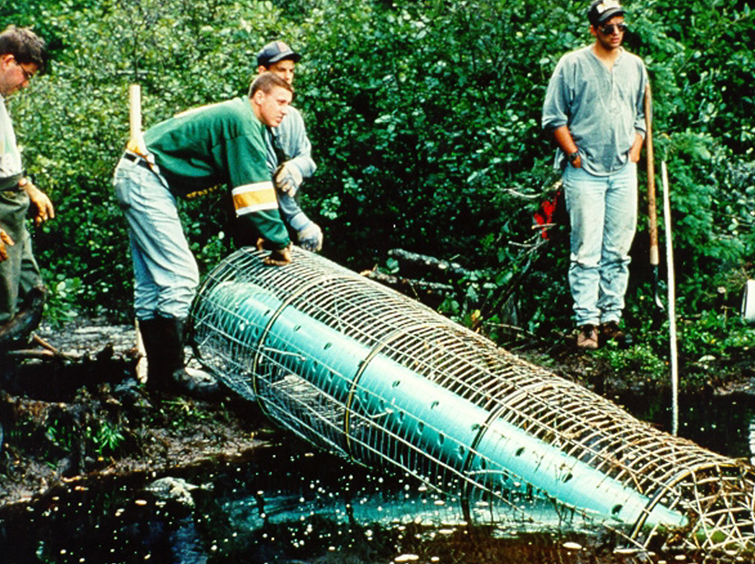
CLEMSON LEVELER
Clemson Levelers work well to manage water levels in rather small drainages. Larger watersheds require larger diameter PVC pipes, which weigh so much that heavy equipment may be needed to move them. That is why most professional installers prefer to use light-weight flex pipes.
None-the-less, Clemsons have a fine record of success, when used appropriately. This device may either be built, or purchased readymade. Other ready-made devices (BeaverStop) to protect culverts or use in dams with larger flowages are available from Canada Culvert (800.565.1152).
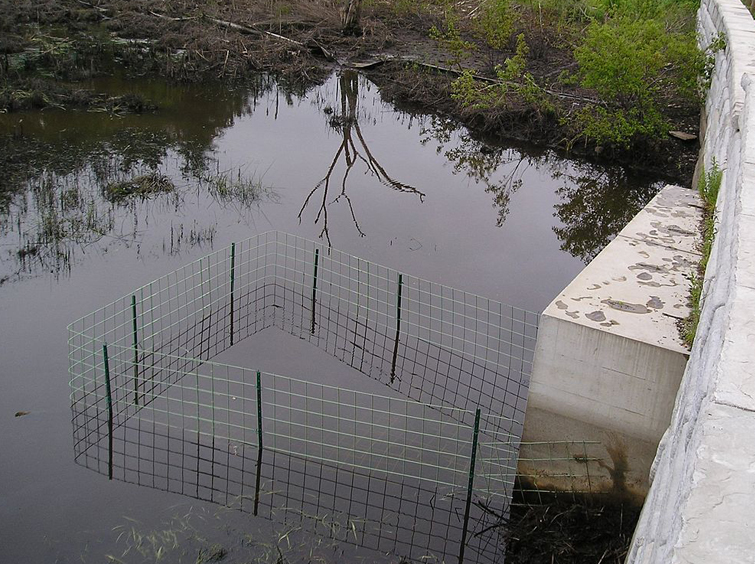
BEAVER DECEIVER
A typical Beaver Deceiver (BD) is either a rectangular fence that protects the upstream opening of a culvert or trapezoidal fence that is narrow at the culvert and widens upstream. Sizes and shapes vary, according to the site. The length of each side of the fence is normally at least twice the diameter of the culvert. Installing this device can be the best solution for a large flowage where the water flow is too great for a pipe system or smaller flowages where roads were built in floodplains. A floor of fencing is usually laid first to deter beaver burrowing.
Skip Lisle of Vermont beaver-proofed many roads on 130,000 acres of Penobscot Indian Nation lands in Maine. His Deceivers, which are often works of art, are made with cedar posts and heavy gauge wire fencing with 6-inch squares (this comes in 5 ft. x 10 ft. sheets or rolls). Culvert protective fences can also be made with steel posts. This device can be the best solution for a large flowage where the water flow is too great for a pipe system or wherever the water level is too close to the road surface.
At busy roads, leaving about 10″ between one of the Deceiver fence posts and the culvert allows wildlife to pass through without risking a traffic accident. This size passageway is too small for beavers to bring in large branches. The sides of the device should be two feet higher than the water level to deter climbing beavers. Beavers do not dam the fence on the sides, an unnatural angle for their damming.
A website on nonlethal beaver control by the King County, WA Natural Resources and Parks Dept. has step by step instructions for building and installing a beaver deceiver. (Here the beaver deceiver is called a receiver fence because a pipe system was used for added security)
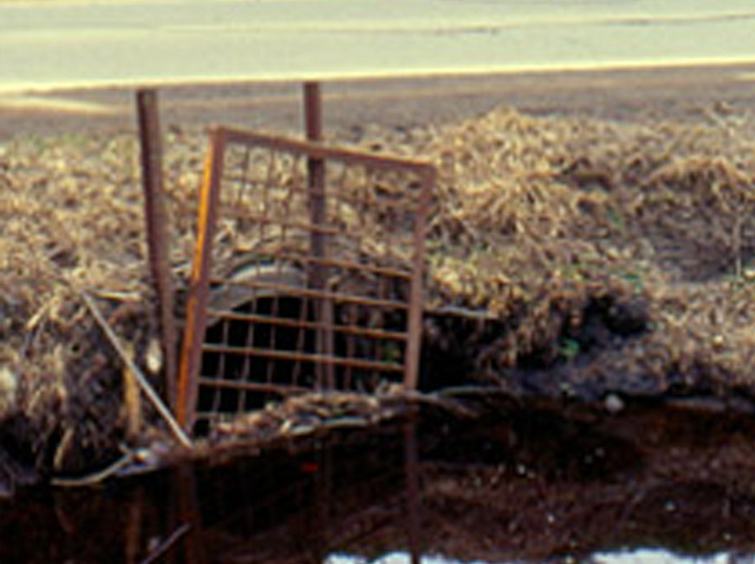
A SHORT-TERM SOLUTION
The typical grate system (shown in the picture to the left) that road crews place in front of culverts may require many man-hours of weekly maintenance. Beavers find these devices quite easy to plug up with branches and mud. The only thing accomplished is that it keeps the beaver from entering the culvert and stuffing it with branches and mud.
Beavers rarely enter the downstream end of the culvert where there’s a leveler or fence upstream. But if they do, it’s best to use large mesh fencing at the outlet as small mesh may become clogged with debris.
The U.S. Fish and Wildlife Service Partners for Wildlife program may supply funding and /or materials for a beaver water level control device if an organized entity (such as a non-governmental organization or an agency) applies. Ready-made devices to protect culverts, or use in dams, are available from BeaverProof Add On, and BeaverStop.

BEAVER CONSULTANTS
Listed by state with Canadian consultants at the bottom.
CALIFORNIA
Sherry, Sierra Wildlife Coalition: (530) 583-9573 or (530) 320-9923, sierrawildlifecoalition@gmail.com.
They install pond levelers and do tree protection.
Kevin Swift, Swift Water Design: (530) 416-1907, kevin@swiftwriting.com, http://www.swiftwaterdesign.com/
He installs flow devices.
COLORADO
Sherri Tippie, Wildlife 2000: (303) 935-4995, sherritippie@comcast.net.
She has relocated hundreds of beavers to areas where their ponds are needed and gives programs.
MAINE
Beaver Brothers, website: http://beaverbros-ecohumanesystems.com
He consults and installs flow devices.
Richard Hesslein, (207) 935-3938, email: rhcastorh3@gmail.com
He consults and installs flow devices.
MASSACHUSETTS
Mike Callahan, Beaver Solutions: (413) 527-6472, mike@beaversolutions.com.
He has installed hundreds of beaver devices and runs the Beaver Management Forum on Facebook.
MONTANA
Amy Chadwick, (406) 250-4024, achadwick@greatwesteng.com.
She installs flow devices and also produces beaver management plans.
NEW YORK
Owen & Sharon Brown, Beavers: Wetlands & Wildlife: (518) 568-2077. BWW@BeaversWW.org.
Consult about beaver problems, occasionally install, give programs nationwide –and elsewhere.
Beavers Work, website: https://wwwnybeaverswork.com, Nico Juarez, 646/363-3887, email: nybeaverswork@gmail.com
OREGON
Jakob Shockey, Beaver State Wildlife Solutions: (541) 761-3312, contact@beaverstatewildlifesolutions.com. & www.beaverstatewildlifesolutions.com.
He installs flow devices and consults on beaver issues.
VERMONT
Skip Lisle, Beaver Deceivers International: http://www.beaverdeceivers.com, (802) 843-1017, skip@beaverdeceivers.com.
He is the U.S. flow device pioneer and has done installations nationwide, plus in Europe.
WASHINGTON
Ben Dittbrenner and Mike Rustay, Beavers Northwest: dittbrenner@gmail.com, (619)708-5434.
They provide technical advice and install beaver flow devices.
The Lands Council, based in Spokane, WA: (509) 838-4912, https://landscouncil.org/about-us/contact/,https://landscouncil.org/what-we-do/beaver-solution/
They relocate beavers and install flow devices.
Methow Beaver Project, email: Methlowbeaverproject@methlowsalmon.org, Hotline: 509/289-2770, website: https://methowbeaverproject.org They do beaver relocations, installs and education.
CANADA
Michel LeClair, (819) 459-2551, michel.leclair@eco-odyssee.ca.
He was the first to install pipe-and-cage type flex levelers during the 1980s. He gives programs and consults.
